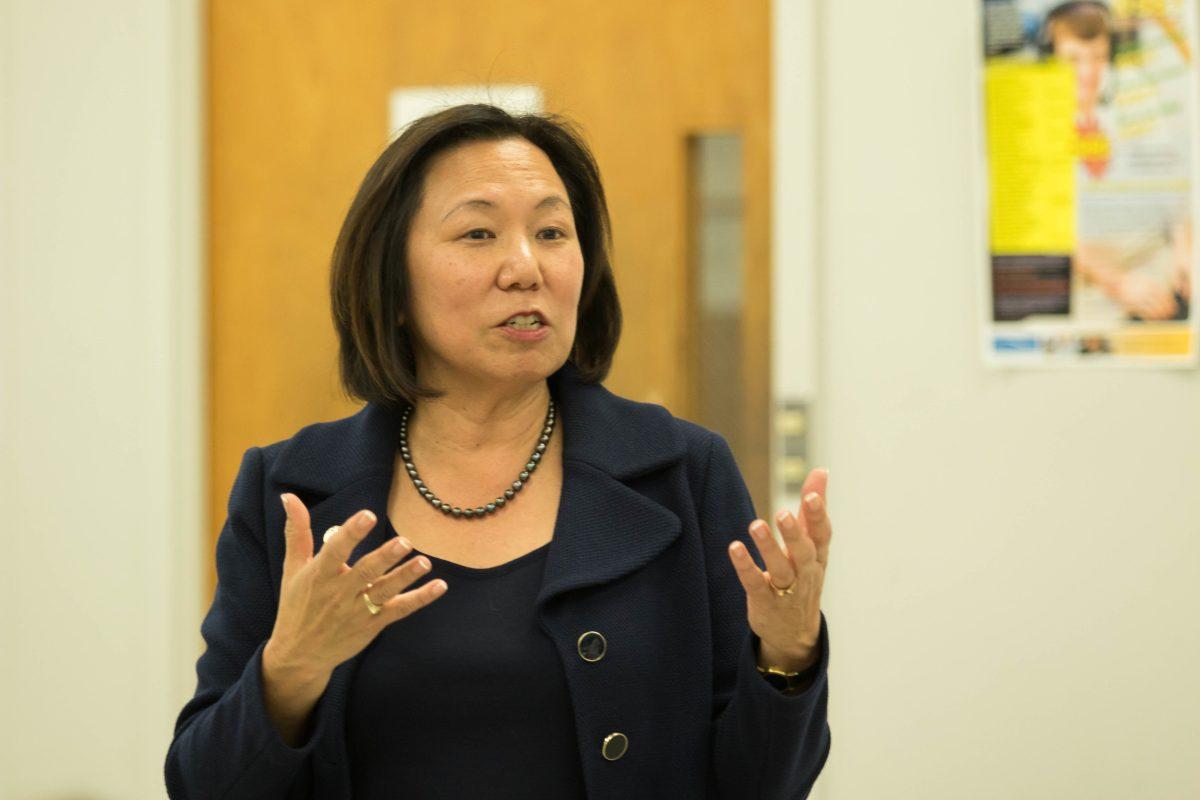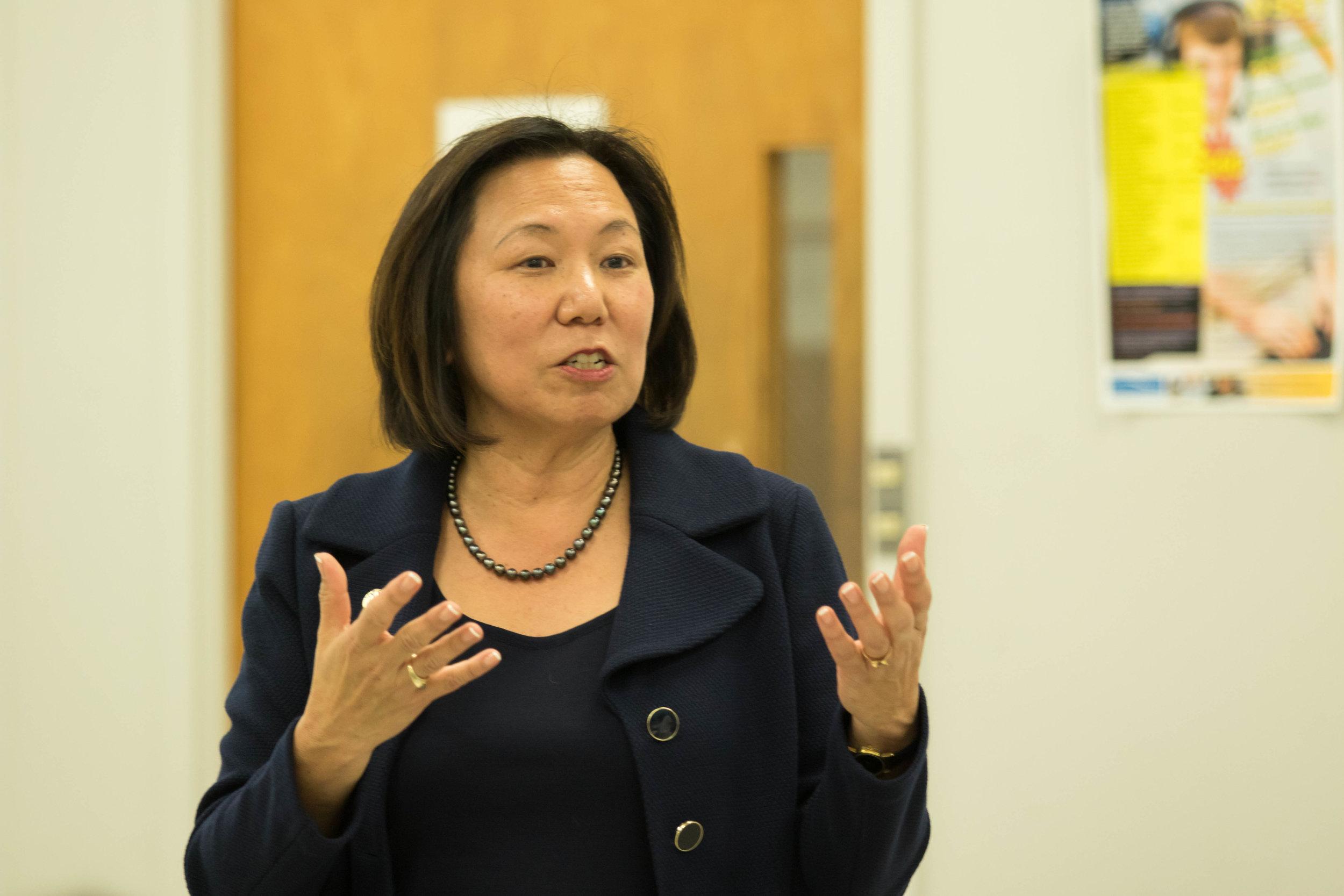Dr. Judy K. Sakaki, Sonoma State University’s new president, took time on Tuesday to meet with the Sonoma State STAR to talk about her first few months on the job and her outlook on what is ahead for the university. Accompanied by her Chief of Staff William Kidder and News and Information Coordinator Nicolas Grizzle, she spent more than an hour answering questions from the STAR staff. What follows is an edited transcript of that discussion.
STAR: How has your transition to Sonoma State been?
Sakaki: “It’s been a really fun transition here. It took some work, too. It’s been really busy because I had to move here. I had to meet and get to know all of the people I’ll be working with, and I had to learn how to get around. Just like whenever you come to a new community, I didn’t know where the grocery store was. You have to find all new things and learn a new community. On campus, the people have been really welcoming and supportive, and I’ve been listening and learning a lot.”
STAR: You said in your convocation speech that you were surprised by the financial state of the campus. In what ways were you surprised?
Sakaki: “I think as I came here and learned, I realized that there were needs on campus. I heard from students that sometimes there were classes that were hard to get into and that you needed them to graduate. So I was surprised that there wasn’t funding set aside to accommodate those needs. You want to think of it as enough money to do things that support students, and I didn’t have that in the way I would have liked. So that was a surprise. So it just means that we have these pots of money around, so you say that this is important, and it is, but you have to be very critical to look at where money was going and then prioritize based on your values.”
STAR: What is your biggest concern for the campus?
Sakaki: “My biggest concern is student success and students. How do we prioritize that, because that is what we’re about; we’re a university, and how do we make sure that we have counseling services, and academic advising, and courses, and what we need.”
STAR: What are the plans for the money now that the MasterCard Pavilion isn’t being built?
Sakaki: “The MasterCard agreement funded some of the series already, and the other part was to come after we built the pavilion. Then they would send $6 million. And since we stopped construction on that, and since that wasn’t operating money, which would have meant that in order to operate it, we would need to take money from somewhere else. So we’re still working in conversation with MasterCard about focusing that pledged $6 million on more academic initiatives.”
STAR: What is your opinion of Lobovision? Do you think it was a good use of money?
Sakaki: “It’s always challenging to take a question of a predecessor or a previous administration. So I’m going to say this: it’s here. I would have asked students: do you want this, or would you rather have something else? But, nevertheless, it’s here, so our issue is now that it’s here, because we can’t undo it, what is the best use for it? How can we use it to our benefit?”
STAR: How do you plan to make Sonoma State a Hispanic-serving institution?
Sakaki: “To be a Hispanic serving institution the university has to get a federal designation, and we have to hit 33 percent…”
Chief of Staff Bill Kidder: “There are a couple of things, some of which are more challenging to us than others. One of the criteria is the percentage of the undergraduate student body is Latino. We hit that, and because of demographics and long-term trends, there’s no turning back on that. The challenge for our campus to become an HSI is to enroll more low-income students from all racial and ethnic backgrounds, including Latinos, but not only Latino students. Currently, we have about 32 percent of students at the undergraduate level who are low-income students. We would need to get that number up to about 38 or 39 percent in order to become eligible.”
Sakaki: “…And when you become an HSI, it helps the campus get access to federal resources that you wouldn’t normally get that could help the whole campus and all students, not just Latino students. So it’s a good thing, and it’s something that we’re working toward.”
STAR: What is the status of the Dream Center?
Sakaki: “When I was at the University of California, I was the one working with undocumented students across the system, and President Janet Napolitano, the UC system president, after listening to undocumented students, decided to allocate $5 million across the UC system for Dream Centers and extra financial aid for undocumented students, and I was responsible for making sure those centers were started, and that the money was going to financial aid. So I was surprised when I learned that Sonoma State was one of three CSUs that did not have a Dream Resource Center. I thought to myself, if anybody read my background on what I cared about and what I was doing, they would hurry up and build a Dream Center before I came here. We’re eventually going to have one. What I have to do is get a really good sense about all of the different needs, and work with my interim cabinet to see what all of the needs are across the university.”
STAR: How will you improve the parking situation?
Sakaki: “I think parking is an issue at every university, and some have differential fees. I have to admit, I haven’t spent a lot of time focused on parking, except for hearing about the concerns and noticing where parking is congested and where parking is wide open but reserved. I probably notice where I park more. In Lot A near Stevenson, I’ve never seen it filled up. So I started thinking, why don’t we just take a section of it and make it open instead of reserved? I think we should open up more parking.”
STAR: What are your goals for your administration regarding transparency?
Sakaki: “When I think of transparency, I think open and accountable. My feeling is, if I know something, you’ll know something. I want to be transparent and open and accountable to you. I will tell you want I know, and together we will think about and come up with the best idea about how to solve something.”





![[Both photos courtesy of sonoma.edu]
Ming-Ting Mike Lee stepped in as the new SSU president following Sakakis resignation in July 2022](https://sonomastatestar.com/wp-content/uploads/2024/04/CC4520AB-22A7-41B2-9F6F-2A2D5F76A28C-1200x1200.jpeg)



























